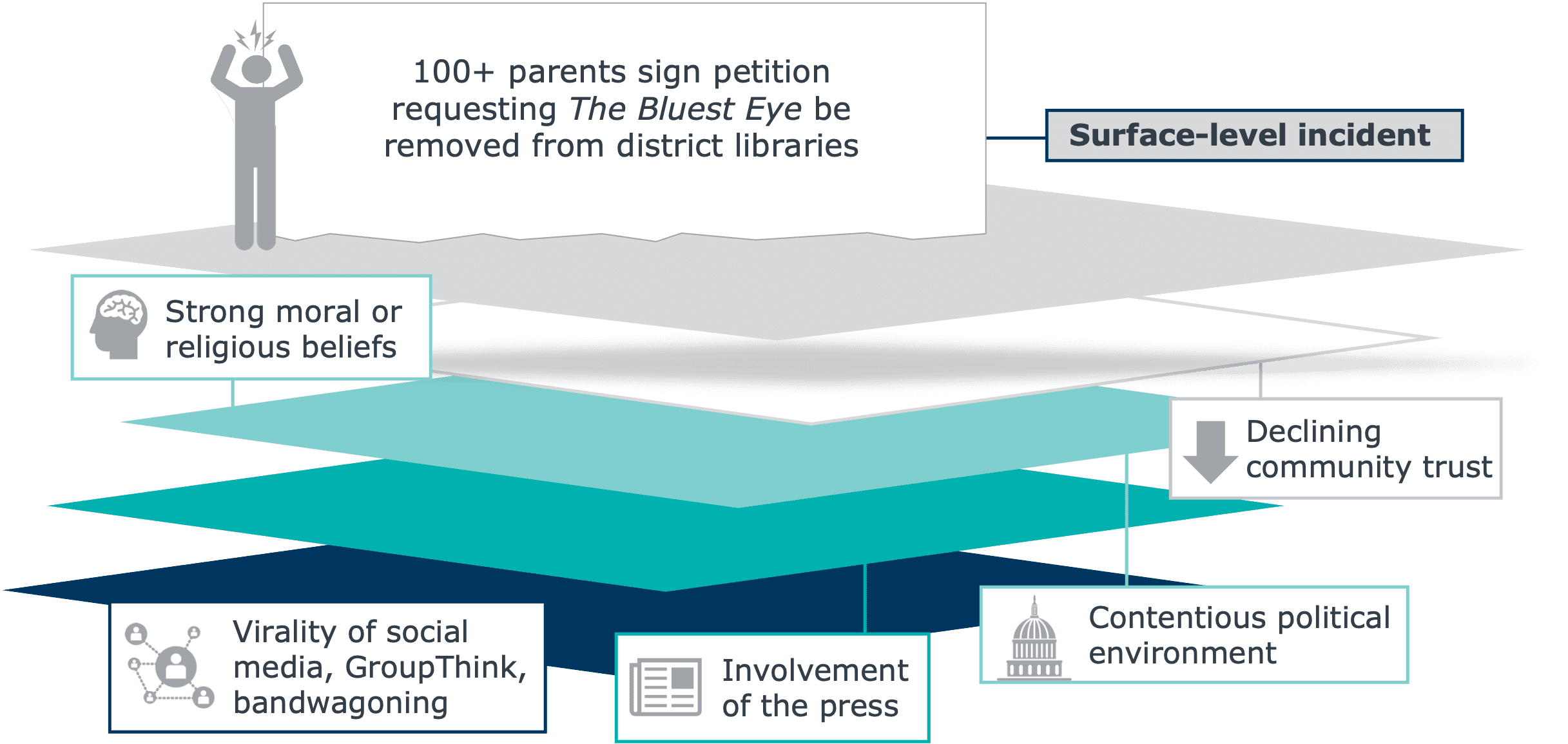Manage divisive conversations and prevent flashpoints in your K-12 district
A decision-making framework for responding to today's complex and controversial issues
July 27, 2022, By Abhilash Panthagani, Associate Director, Strategic Research and Margaret Sullivan, Associate Director, Research
Superintendents today are forced to contend with frequent, divisive issues that turn into district-wide flashpoints. 80% of superintendents in EAB’s 2022 Voice of the Superintendent survey agree that managing divisive conversations is now the most challenging aspect of their job.
The time superintendents invest in responding to flashpoints distracts from strategic initiatives, impacting student outcomes and exhausting leadership at a time when student learning and teacher morale are at all-time lows.
What’s worse, these flashpoints are not as straightforward as they were in the past and are deeply rooted in moral beliefs, politics, and the media. As such, they are more likely to cause decision fatigue and chronic stress, leaving superintendents unsure of how to resolve them and more likely to make costly mistakes.
-
Flashpoint
A controversy causing a disturbance in the district due to public activism, criticism, or reputational damage
Example of what lies beneath today’s flashpoints
Break down district flashpoints into manageable components
Today’s flashpoints require a new approach—one that will allow district leaders to reduce flashpoints’ impact on students and strategic initiatives.
EAB studied a variety of management professionals who excel in flashpoint-ridden environments—from first responders and crisis management consultants to air traffic controllers—to see how they solve problems in high-stress situations. We noticed a similar methodology among these high-stress professions:
- Diagnosing the type of problem at hand
- Applying optimal strategies that work best for that type of problem
To facilitate this process, these professions call upon problem-solving frameworks—one of which, Cynefin, is directly applicable to district leaders’ experience navigating modern flashpoints. Cynefin is a business decision-making framework created by an IBM employee that has since helped solve problems in fields ranging from counterterrorism to pharmaceutical strategy.
Apply the Cynefin framework to find the best strategy for each flashpoint component
-
Cynefin
A problem-solving framework that sorts problems into four categories and leads executives to solutions that work best
- Clear: Has been solved before and best practices exist
- Complicated: Can be solved through help of an expert
- Complex: Unprecedented; solved through trial and error
- Chaotic: No control at all; need to establish constraints
Though today’s multi-faceted flashpoints cannot be categorized into one category, district leaders should apply the framework to determine how to respond to a flashpoint by diagnosing optimal strategies for each question or problem they face.
Cynefin in action
While the Cynefin framework is new in the field of education, some districts have already applied similar ways of thinking when responding to flashpoints. North Shore School District demonstrated how breaking down a larger flashpoint into individual components and diagnosing appropriate strategies helped resolve the flashpoint with incredible speed and accuracy.
In 2016, severe community backlash on social media contributed to the failure of a $200 million referendum ballot initiative at North Shore. District leaders were uncertain of the best strategies to solve the problem, leading to two years of inaction and ineffective district response.
In 2018, having learned from their mistakes, district leaders were able to significantly reduce flashpoint response time to a new ballot initiative by identifying individual problems and deploying optimal strategies for each one.
A new approach: In 2018, Superintendent Mike Lubelfeld, his board, and the leadership team applied strategies optimized for each type of problem they faced to rebuild community trust in a fraction of the time. Click into each box below to reveal the optimal strategy used by North Shore to respond to each flashpoint sub-problem.
-
Problem Type: Chaotic
How do we manage social media backlash?
Solution: Deploy community dialogue platform to proactively gather feedback
-
Problem Type: Complex
How can we easily incorporate community feedback?
Solution: Assemble a rapid response committee to react to feedback in real time
-
Problem Type: Complicated
How can we ensure the right experts are consulted?
Solution: Engage subject matter experts to expedite decision-making
-
Problem Type: Clear
How can we avoid backlash in the future?
Solution: Create a template of best practices to prepare for next time
Select strategies that work best for each type of problem
Clear
Tactic: Triage “Stoplight”
Simplify decision-making for responding publicly to controversial flashpoints by proactively deciding which topics are mission critical, mission indirect, or mission unrelated. A simple stoplight framework can help categorize topics into color zones: green (respond), yellow (deliberate case-by-case), and red (do not respond).

Green zone
Mission critical
Impact: Direct impact on students and educational mission

Yellow zone
Mission indirect
Impact: Indirect impact on students/staff, but not mission

Red zone
Mission unrelated
Impact: Unrelated to educational mission
This framework ensures superintendents’ public communications are consistent based on the type of flashpoint presented. At best, this assures the community, and at worst, gives them one less reason to criticize the district’s response.
Complicated
Tactic: Peer-informed risk register
Flashpoints are variable and unexpected, but effective responses are not. Similar incidents raise similar questions, such as ‘what did we say last time and how do our peers respond to these incidents?’. Gathering this information is important to composing a response, but it is also time-consuming and repetitive. Develop a peer-informed risk register to quickly access and benefit from this information when flashpoints strike.
Step 1: Templatize flashpoint responses to expedite initial response
- Identify most common or likely flashpoints from list of possible risks
- Review responses from peers and identify common elements
- Draft, approve, and disseminate template packages to staff
Step 2: Cross-check your flashpoint response with peer districts
A risk register is a tool to organize risks and responses in one location. It allows districts to assign flashpoint risks to categories, score them based on severity, and monitor responses.
Identify: Conduct district-wide analysis
- Start with EAB’s template of common risks
- Use meetings or online surveys to source additional risks
Verify: Collaborate to verify, discover risks
- Collect and compare peer districts’ risk registers
- Remove non-applicable risks and consider overlooked risks
Codify: Build/update risk register
- Use risks identified from meetings and peers to build your district’s risk register
- Review and refresh the risk register regularly
Complex
Tactic: Parent reps
Complex problems have no silver bullet solution, but instead are whittled down to a more manageable problem by testing different “tools in your toolbox” for the one that actually gets results. Parents are often the most complex flashpoint layer, driving many complex flashpoints, so it’s imperative to build more productive partnerships with parents, such as through a parent reps program.
Specially trained parents serve as reps
Reps receive district-level administered training on how to have constructive dialogue in school settings (e.g., parking lot)
Parent reps keep pulse on community
Parent reps meet regularly with school parent rep coordinator and the principal
Reps mediate and raise issues to the principal
Reps mediate or intervene in parent misunderstandings and elevate emerging issues to the principal
Chaotic
Tactic: Large group constraints
Board meetings have gone from straightforward to chaotic due to the nationalization of local politics, declining news coverage of district operations, and the virality of social media. District leaders must apply appropriate constraints to ensure board meetings do not delve into further chaos.
- Public comment: Standardize a process for allocating time and facilitating public comment
- Media presence: Invite reporters to interview district leaders after the meeting and prepare statements in advance
- Police/security interference: Define “disruption” prior to the meeting to avoid unnecessary police/security involvement
- Political controversy: Do not engage in emotional debate; refer to district strategic plan and use student-first language


More Blogs

From cell phones to STEM: What district leaders are focused on right now

Building systems for principal success: 3 key lessons for district leadership

